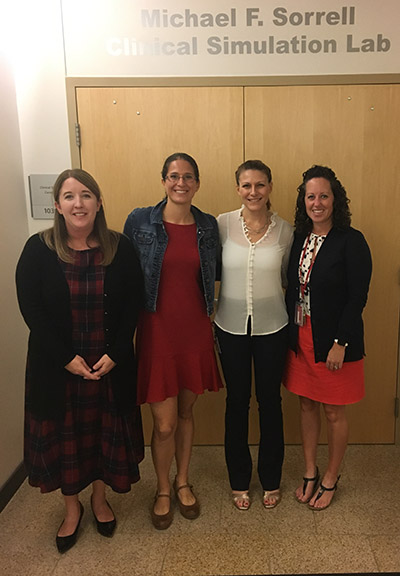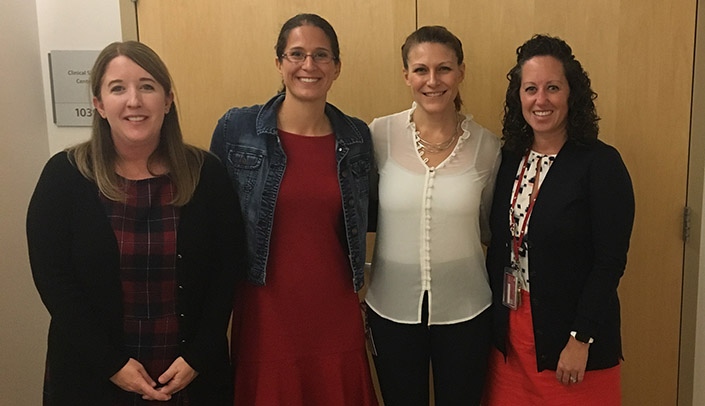Students and faculty from the College of Allied Health Professions and College of Pharmacy are learning how their professions can work together toward an important goal — helping patients with diabetes better self-manage their conditions, and thus, live healthier lives.
 |
Kristen Cook, Pharm.D., Carey Wheelhouse, Annie Wildermuth and Megan Timmerman collaborated to develop an interprofessional education (IPE) approach for pharmacy, physician assistant and medical nutrition students to better work with diabetes patients. |
This interprofessional approach can be applicable anywhere, but may be especially beneficial, “in rural settings, where providers often have less resources and rely on the full scope of knowledge of other practitioners,” said Annie Wildermuth, assistant professor of physician assistant education. “That collaborative knowledge sharing is what’s happening here.”
Wildermuth, Carey Wheelhouse, assistant professor of PA education, Kristen Cook, Pharm.D., clinical associate professor of pharmacy practice, and Megan Timmerman, assistant professor, medical nutrition education, collaborated to develop an interprofessional education (IPE) approach, through a College of Allied Health Professions pilot grant.
Twenty-nine pharmacy, PA, and medical nutrition students worked together to learn the “Alphabet Strategy,” a mnemonic that helps patients remember important aspects of diabetes management.
Students in the project participated in three activities. First, students formed interprofessional teams and discussed their profession’s training, scope of practice, and experience with diabetic patients.
“The students discovered how much knowledge other professions have; my colleagues and I overheard comments like, ‘Wow, you know so much about metformin or diabetic diets,’ ” Dr. Cook said.
Next, students learned their Alphabet Strategy ABCs. Students in each profession taught their group the letters, providing every student knowledge to teach the full Alphabet Strategy to a patient. Students also learned about the importance of health literacy in communicating with patients.
“The intention of this activity was for students, as an interdisciplinary team, to create a plan to educate a patient using the Alphabet Strategy,” Timmerman said.
Finally, the case study “came to life”; interprofessional student groups educated a mock patient on the Alphabet Strategy.
“To assess effectiveness of education, mock patients were quizzed on the Alphabet Strategy after the encounter,” Wheelhouse said. Students also self-reflected on a video recording of their encounter.
The Alphabet Strategy is being put to good use by these students. Pharmacy students Ashley Lopez and Madison Egeberg praised the project.
“I can see how much better it is when we all work together. There’s so much we can teach a patient collaboratively to help them be successful managing their illness,” Lopez said.
Jason Lee, a PA student now on clinical rotations, said, “I’ve been asked to share the Alphabet Strategy with the providers and nurse educators at the clinic to streamline the education process and raise patient adherence . . . I’ve even had one patient parrot some of it back to me at a follow-up visit!”
